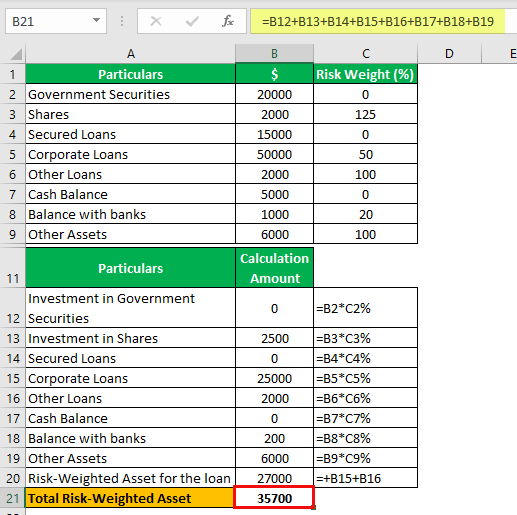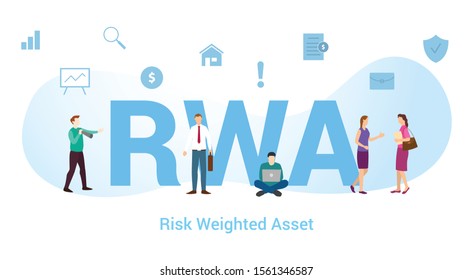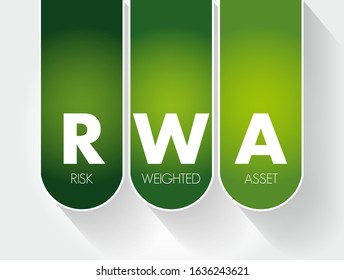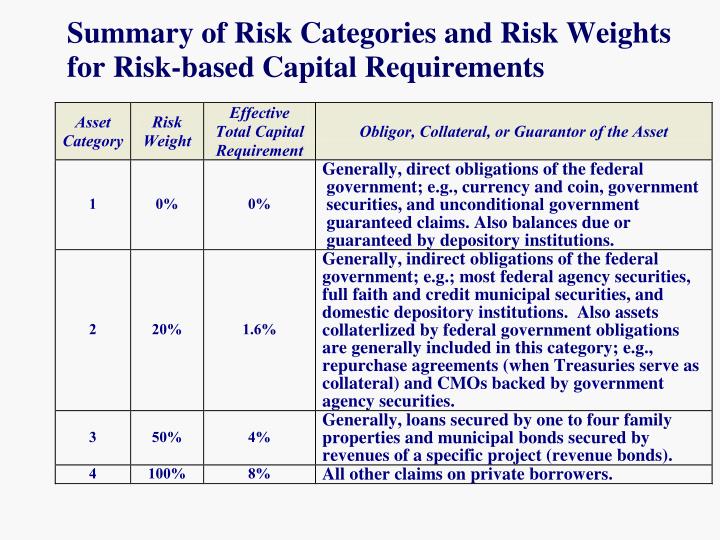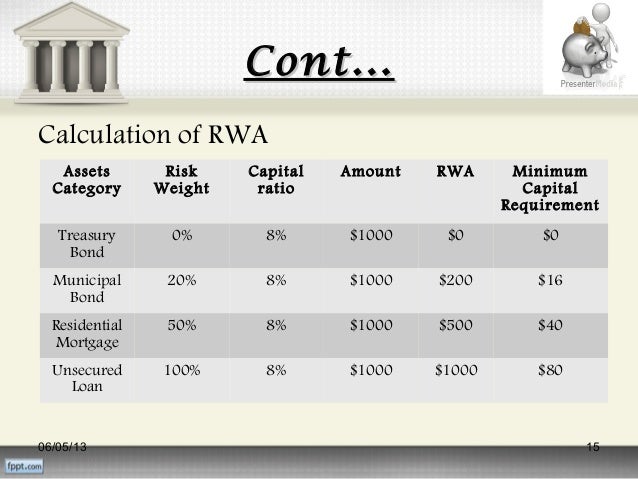Unlocking the Secrets of RWA: Understanding the Basics
In the world of banking and finance, Risk-Weighted Assets (RWA) play a vital role in determining a bank’s capital requirements and risk exposure. RWA calculation is a critical process that helps banks quantify their risk and allocate sufficient capital to cover potential losses. The calculation of RWA is used to determine the minimum amount of capital a bank must hold in reserve to meet regulatory requirements. This is crucial, as it directly impacts a bank’s ability to lend, invest, and operate efficiently. By understanding the basics of RWA, banks can better manage their risk, optimize their capital allocation, and ensure compliance with regulatory requirements. In essence, RWA calculation is a complex process that requires a deep understanding of risk-weighted assets and their impact on a bank’s overall risk profile. In this article, we will delve into the world of RWA, exploring its significance, calculation methods, and applications in modern banking.
How to Calculate RWA: A Step-by-Step Approach
Calculating Risk-Weighted Assets (RWA) is a complex process that requires a thorough understanding of the different approaches and formulas involved. There are three main approaches to RWA calculation: standardized, Internal Ratings-Based (IRB), and advanced IRB. Each approach has its own set of formulas and requirements, and banks must choose the approach that best suits their risk profile and regulatory requirements. In this section, we will provide a step-by-step guide on how to calculate RWA using each approach, highlighting the key formulas and considerations involved.
The standardized approach is the simplest and most widely used method, which assigns a fixed risk weight to each asset class based on its credit rating. The IRB approach, on the other hand, allows banks to use their own internal credit ratings and probability of default estimates to calculate RWA. The advanced IRB approach is a more sophisticated method that takes into account additional risk factors, such as loss given default and exposure at default. By understanding the different approaches and formulas involved in RWA calculation, banks can ensure accurate and reliable results that meet regulatory requirements.
For instance, the standardized approach uses the following formula to calculate RWA: RWA = (asset value x risk weight) x 8%. The IRB approach, on the other hand, uses the following formula: RWA = (asset value x probability of default x loss given default x exposure at default) x 8%. By using these formulas and approaches, banks can calculate their RWA with precision and accuracy, ensuring compliance with regulatory requirements and effective risk management.
The Role of Credit Risk in RWA Calculation
Credit risk plays a crucial role in Risk-Weighted Assets (RWA) calculation, as it directly impacts a bank’s capital requirements and risk exposure. Credit risk refers to the likelihood of a borrower defaulting on a loan or credit obligation, resulting in a loss for the bank. In RWA calculation, credit risk is assessed through the probability of default (PD), loss given default (LGD), and exposure at default (EAD). These metrics are used to calculate the credit risk component of RWA, which is a critical component of a bank’s overall risk profile.
The probability of default (PD) is a measure of the likelihood that a borrower will default on a loan or credit obligation. This metric is typically expressed as a percentage and is used to calculate the expected loss in the event of default. The loss given default (LGD) is a measure of the expected loss in the event of default, expressed as a percentage of the exposure at default. The exposure at default (EAD) is the total value of the loan or credit obligation at the time of default.
In RWA calculation, credit risk is calculated using the following formula: Credit Risk RWA = (PD x LGD x EAD) x 8%. This formula takes into account the probability of default, loss given default, and exposure at default to calculate the credit risk component of RWA. By accurately assessing credit risk, banks can ensure that they hold sufficient capital to cover potential losses and maintain regulatory compliance.
Accurate credit risk assessment is critical in RWA calculation, as it directly impacts a bank’s capital requirements and risk exposure. Banks must use robust credit risk models and data to ensure that their credit risk assessments are accurate and reliable. By doing so, banks can ensure that their RWA calculations are accurate and reliable, and that they are well-equipped to manage their credit risk exposure.
Market Risk and RWA: Understanding the Connection
Market risk is a critical component of Risk-Weighted Assets (RWA) calculation, as it directly impacts a bank’s capital requirements and risk exposure. Market risk refers to the potential loss or gain in value of a bank’s assets and liabilities due to changes in market conditions, such as interest rates, equity prices, and commodity prices. In RWA calculation, market risk is quantified using various metrics, including value-at-risk (VaR) and expected shortfall (ES).
Value-at-risk (VaR) is a measure of the potential loss in value of a bank’s assets and liabilities over a specific time horizon, typically one day, with a given probability, usually 99%. Expected shortfall (ES) is a measure of the potential loss in value of a bank’s assets and liabilities beyond the VaR, providing a more comprehensive view of market risk. Both VaR and ES are used to calculate the market risk component of RWA, which is a critical component of a bank’s overall risk profile.
There are three main types of market risk that affect RWA calculation: interest rate risk, equity risk, and commodity risk. Interest rate risk arises from changes in interest rates, which can impact the value of a bank’s assets and liabilities. Equity risk arises from changes in stock prices, which can impact the value of a bank’s equity investments. Commodity risk arises from changes in commodity prices, which can impact the value of a bank’s commodity-related assets and liabilities.
In RWA calculation, market risk is calculated using the following formula: Market Risk RWA = (VaR x 12.5) + (ES x 12.5). This formula takes into account the VaR and ES metrics to calculate the market risk component of RWA. By accurately quantifying market risk, banks can ensure that they hold sufficient capital to cover potential losses and maintain regulatory compliance.
Accurate market risk assessment is critical in RWA calculation, as it directly impacts a bank’s capital requirements and risk exposure. Banks must use robust market risk models and data to ensure that their market risk assessments are accurate and reliable. By doing so, banks can ensure that their RWA calculations are accurate and reliable, and that they are well-equipped to manage their market risk exposure.
Operational Risk and RWA: The Often-Overlooked Factor
Operational risk is a critical component of Risk-Weighted Assets (RWA) calculation, yet it is often overlooked in favor of credit and market risk. Operational risk refers to the risk of loss resulting from inadequate or failed internal processes, systems, and people, or from external events. In RWA calculation, operational risk is quantified using various metrics, including the basic indicator approach, the standardized approach, and the advanced measurement approach.
The basic indicator approach is a simple method that assigns a fixed percentage of a bank’s gross income to operational risk. The standardized approach is a more advanced method that uses a set of business indicators to estimate operational risk. The advanced measurement approach is a sophisticated method that uses a bank’s internal data to estimate operational risk. Each approach has its own strengths and weaknesses, and banks must choose the approach that best suits their needs.
Operational risk affects RWA calculations in several ways. Firstly, operational risk can lead to financial losses, which can impact a bank’s capital requirements. Secondly, operational risk can impact a bank’s reputation and customer confidence, which can lead to a decline in business. Finally, operational risk can lead to regulatory penalties and fines, which can further erode a bank’s capital base.
To accurately assess operational risk, banks must identify and assess potential operational risk events, such as fraud, cyber attacks, and natural disasters. Banks must also develop robust risk management frameworks to mitigate operational risk, including risk assessment, risk monitoring, and risk reporting. By doing so, banks can ensure that their RWA calculations are accurate and reliable, and that they are well-equipped to manage their operational risk exposure.
In RWA calculation, operational risk is calculated using the following formula: Operational Risk RWA = (Operational Risk Capital Requirement x 12.5). This formula takes into account the operational risk capital requirement, which is calculated using one of the three approaches mentioned earlier. By accurately quantifying operational risk, banks can ensure that they hold sufficient capital to cover potential losses and maintain regulatory compliance.
Common Challenges in RWA Calculation and How to Overcome Them
Risk-Weighted Assets (RWA) calculation is a complex process that requires accurate data, robust models, and a deep understanding of risk management principles. Despite its importance, RWA calculation is often plagued by common challenges and pitfalls that can lead to inaccurate results and regulatory non-compliance. In this section, we will identify common challenges in RWA calculation and provide tips and best practices on how to overcome them.
Data quality issues are a common challenge in RWA calculation. Inaccurate or incomplete data can lead to incorrect RWA calculations, which can have significant implications for a bank’s capital requirements and risk exposure. To overcome data quality issues, banks must implement robust data management systems that ensure data accuracy, completeness, and consistency.
Model risk is another common challenge in RWA calculation. Model risk refers to the risk of inaccurate or incomplete models that can lead to incorrect RWA calculations. To overcome model risk, banks must implement robust model validation processes that ensure models are accurate, reliable, and consistent with regulatory requirements.
Regulatory requirements are a significant challenge in RWA calculation. Banks must comply with complex regulatory requirements, such as Basel III and IV, which can be time-consuming and resource-intensive. To overcome regulatory requirements, banks must stay up-to-date with regulatory changes and implement robust compliance processes that ensure regulatory compliance.
In addition to these challenges, banks may also face other challenges, such as inadequate risk management frameworks, insufficient resources, and lack of expertise. To overcome these challenges, banks must implement robust risk management frameworks, invest in sufficient resources, and develop expertise in RWA calculation.
To overcome common challenges in RWA calculation, banks must adopt best practices, such as:
- Implementing robust data management systems to ensure data accuracy and completeness.
- Validating models regularly to ensure accuracy and reliability.
- Staying up-to-date with regulatory changes and implementing robust compliance processes.
- Investing in sufficient resources and developing expertise in RWA calculation.
- Implementing robust risk management frameworks to identify and manage risk.
By adopting these best practices, banks can ensure accurate RWA calculations, comply with regulatory requirements, and manage risk effectively. Accurate RWA calculation is critical in banking and finance, and banks must overcome common challenges to ensure accurate and reliable results.
RWA Calculation Tools and Software: A Review of Popular Options
In today’s fast-paced banking and finance industry, accurate RWA calculation is crucial for banks to manage risk and comply with regulatory requirements. With the increasing complexity of RWA calculation, banks are turning to specialized tools and software to streamline the process. In this section, we will review popular RWA calculation tools and software, including their features, benefits, and limitations.
One of the most popular RWA calculation tools is the RiskCalc platform, which offers a comprehensive solution for RWA calculation, including credit risk, market risk, and operational risk. The platform provides advanced analytics and reporting capabilities, making it an ideal choice for banks of all sizes.
Another popular option is the SAS Risk Management platform, which offers a robust solution for RWA calculation, including data management, model validation, and regulatory compliance. The platform is highly customizable and can be integrated with existing systems, making it a popular choice among banks.
The Moody’s Analytics RiskWeight platform is another popular option, which offers a comprehensive solution for RWA calculation, including credit risk, market risk, and operational risk. The platform provides advanced analytics and reporting capabilities, making it an ideal choice for banks looking to improve their risk management capabilities.
In addition to these popular options, there are several other RWA calculation tools and software available, including the Oracle Financial Services RWA platform, the FIS RWA calculation platform, and the Wolters Kluwer RWA calculation platform. Each of these platforms offers unique features, benefits, and limitations, and banks must carefully evaluate their options to choose the right tool for their needs.
When choosing an RWA calculation tool or software, banks must consider several factors, including the platform’s ability to handle complex RWA calculations, its scalability and flexibility, and its ability to integrate with existing systems. Banks must also consider the platform’s reporting capabilities, including its ability to provide transparent and accurate RWA reports.
In conclusion, RWA calculation tools and software play a critical role in helping banks manage risk and comply with regulatory requirements. By choosing the right tool, banks can streamline their RWA calculation process, improve their risk management capabilities, and ensure accurate and reliable RWA reports. With the increasing complexity of RWA calculation, banks must stay up-to-date with the latest tools and software to remain competitive in today’s fast-paced banking and finance industry.
Best Practices for RWA Calculation and Reporting
Accurate RWA calculation and reporting are crucial for banks to manage risk and comply with regulatory requirements. In this section, we will discuss best practices for RWA calculation and reporting, including data management, model validation, and regulatory compliance.
Data management is a critical component of RWA calculation and reporting. Banks must ensure that their data is accurate, complete, and consistent across all systems. This includes data on credit risk, market risk, and operational risk, as well as data on capital requirements and risk exposure. Banks should implement robust data management processes, including data validation, data cleansing, and data quality checks.
Model validation is another critical component of RWA calculation and reporting. Banks must ensure that their RWA models are accurate, reliable, and consistent with regulatory requirements. This includes validating the models against historical data, back-testing the models, and stress-testing the models. Banks should also implement robust model validation processes, including model documentation, model testing, and model approval.
Regulatory compliance is a critical component of RWA calculation and reporting. Banks must ensure that their RWA calculations and reports comply with regulatory requirements, including Basel III and IV, and local regulatory requirements. Banks should implement robust compliance processes, including regulatory reporting, compliance monitoring, and compliance testing.
Transparency and accuracy are essential in RWA reporting. Banks must ensure that their RWA reports are transparent, accurate, and reliable, and that they provide a clear picture of the bank’s risk exposure and capital requirements. Banks should implement robust reporting processes, including report validation, report testing, and report approval.
In addition to these best practices, banks should also implement robust governance and oversight processes, including risk management committees, audit committees, and regulatory compliance committees. These committees should oversee the RWA calculation and reporting process, ensure that the process is accurate and reliable, and identify and mitigate any risks or issues.
By following these best practices, banks can ensure that their RWA calculation and reporting processes are accurate, reliable, and compliant with regulatory requirements. This will enable banks to manage risk effectively, comply with regulatory requirements, and maintain a strong capital position. In today’s fast-paced banking and finance industry, accurate RWA calculation and reporting are critical for banks to remain competitive and successful.
In the context of RWA risk weighted assets calculation, it is essential to prioritize accuracy, transparency, and reliability. By doing so, banks can ensure that their RWA calculations and reports provide a clear picture of their risk exposure and capital requirements, enabling them to make informed decisions and manage risk effectively.

